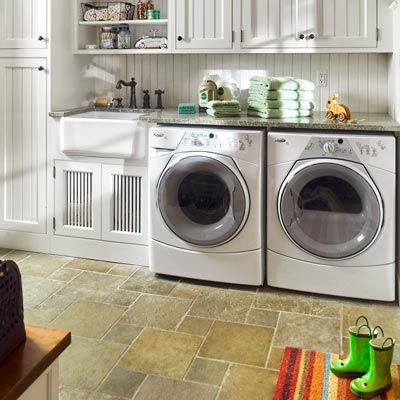
A laundry room can be more than just a utilitarian space. You can turn it into a bright and organized command center for household cleanup. In our guide, we’ll provide tips for updating your laundry space, covering everything from energy-efficient appliances and affordable flooring options to optimal layouts and safety measures.
Where To Put It
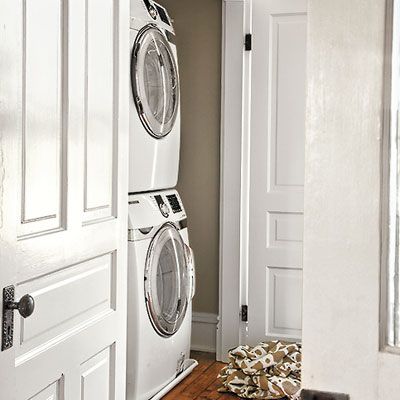
The best laundry room location for your home will depend on several factors. While the basement is a popular choice, others prefer to place their laundry facilities closer to their home’s bedrooms or the kitchen. Here’s what to consider as you decide where to put your laundry room:
On an Upper Floor
Installing laundry facilities on an upper floor can be convenient, but it can also be challenging. We’ve outlined the pros and cons of an upper-floor laundry facility below:
Pros:
- Proximity to where dirty clothes accumulate reduces the distance you have to transport laundry baskets.
- You can tap into existing plumbing lines if your laundry room is near a bathroom.
Cons:
- Closet installations require a vented door and additional space around stacked machines to dissipate dryer heat.
- Leaks can potentially damage the rooms below.
- Noise and vibration from appliances require extra insulation and a motion-arresting pad.
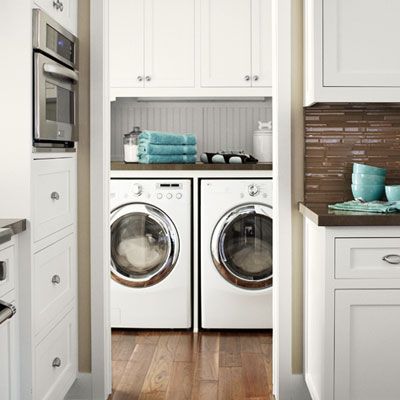
On the First Floor
A first-floor laundry room is also convenient, but there are some drawbacks. Here are some of the pros and cons:
Pros:
- Locating the laundry room near other housekeeping areas can streamline household chores, making it easier to manage laundry while cooking or performing other tasks.
- You may be able to share plumbing lines with the kitchen or bathroom.
Cons:
- Integrating the laundry space with other living areas requires careful planning.
- Machines hidden in cabinets require vented doors and clearance space for proper ventilation.
- Proximity to other high-traffic areas of your home can lead to laundry accumulating in the kitchen or dining areas.
- You’ll need to carry hampers up and down stairs if your home’s bedrooms aren’t on the first floor.
How To Make the Most of Limited Space
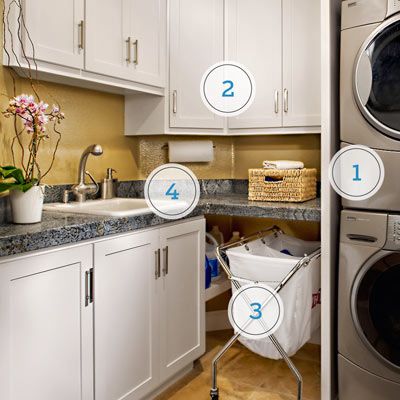
You don’t need a lot of space for an efficient laundry room. Some of the most effective designs are compact and feature the following four key elements arranged near one another:
- Appliances: Stack them or place them side by side so you can easily transfer wet clothes from the washer to the dryer. Position machines directly in front of utility hookups.
- Baskets: Leave enough room in front of machines for easy loading and unloading. Create a nearby niche to store baskets or hampers out of the way but within easy reach.
- Supplies: Store detergent, stain removers, and other laundry care items in closed cabinets, cubbies, or open shelving above or next to the machines.
- Work surface: Add a counter or freestanding table adjacent to stacked or top load machines for sorting, treating stains, and folding. For side-by-side front loaders, consider installing a counter. You can also use a pegboard or wall-mounted organizers to keep frequently used items within arm’s reach.
Check Clearances Before Installing
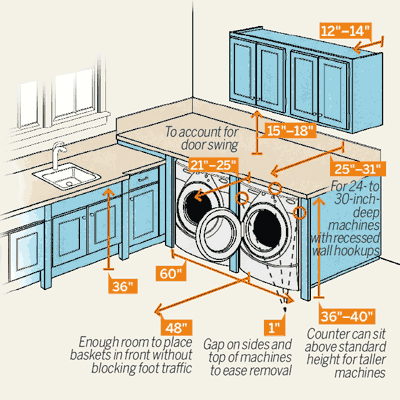
When planning your laundry room layout, consider the following measurements for optimal usability:
- 1 inch around all sides of each machine so you can easily slide them out of cabinets, recesses, and other tight spaces
- 6 inches between the back of the machine and the wall for ventilation
- 21–25 inches around doors to account for door swing clearance
- 48 inches in front of machines to place a basket and easily load and unload laundry
- 60 inches of width to place a washer and dryer side by side
We recommend these measurements for counters:
- 12–14 inches of depth for wall-mounted cabinets
- 15–18 inches between the tops of counters or machines and the bottoms of wall-mounted cabinets
- 25–31 inches of depth for counters above front load machines
- 36–40 inches of height for counters above and around machines
Delivery day reminder: Measure not only the area where you plan to install the machines but also the doorways and stairwells they must pass through. Most machines require about a 30-inch-wide opening.
Why We Like Front-Load Washers
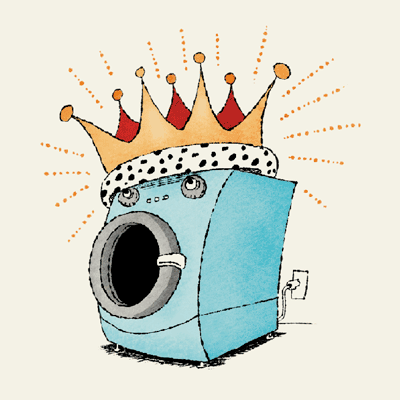
Front-load washers typically cost more than top-loaders but they offer several advantages, including the following:
- Better cleaning performance and efficiency
- Design flexibility—you can stack with a dryer to save floor space or top with a counter for folding
- Ergonomic benefits when raised on a pedestal—no need to bend deeply as with top load machines
- Faster spin cycles (up to 1,500 revolutions per minute) that extract more water, which reduces drying time and energy consumption
Front Loader Add-On: Pedestals
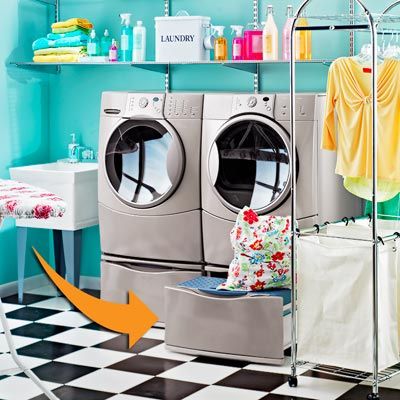
Average cost: $100–$300*
Pedestals offer several benefits for front load washers and dryers, including the following:
- The drawers are typically 12–15 inches deep, perfect for storing detergent bottles upright.
- They elevate appliances to a more comfortable height, reducing the need to bend over.
- They provide storage in tight spaces without consuming additional floor area.
You can often order pedestals directly from the appliance manufacturer, ensuring a perfect match for your machines.
*All cost figures in this article are averages sourced from product pages hosted on major home retailers.
Front Loader Add-On: Countertop
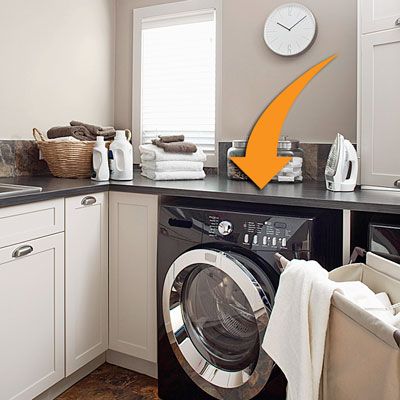
Average cost: $200–$800
A countertop over front load machines offers several advantages, including the following:
- It creates a large work surface for sorting, treating stains, and folding laundry.
- It prevents items from falling between or behind appliances.
- You can tailor a countertop to your laundry room by buying a custom counter or a prefab rubber tray with a built-in backsplash and storage pockets for laundry supplies.
Look for durable countertop surfaces such as laminate, solid surface, or engineered stone. These options are moisture- and stain-resistant, which ensures easy maintenance and a long lifespan.
Safety Tips
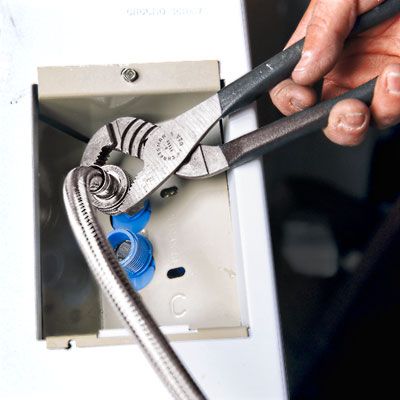
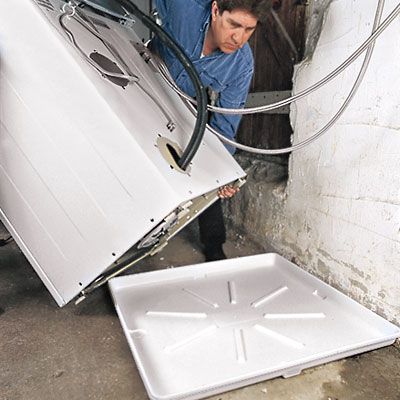
Washer mishaps are among the leading causes of home floods, while dryers cause thousands of fires annually. Implement the following safety measures to protect your home:
- Always ensure the dryer vent is clear of obstructions and has proper air circulation to reduce fire risk.
- Complete regular maintenance checks—such as cleaning lint filters and inspecting hoses and vents for wear and tear—to help prevent accidents.
- Install metal dryer vent pipes sealed with foil tape. Avoid plastic flex hoses that pose a fire hazard.
- Install an automatic shutoff valve to cut water supply in the event of a leak or burst hose.
- Use a recessed washer box to easily access water valves and prevent hose damage.
- Use a washer drain pan for drips, especially for machines on main living levels.
- Use braided steel washer hoses instead of rubber ones to prevent splitting.
Gas vs. Electric Dryers
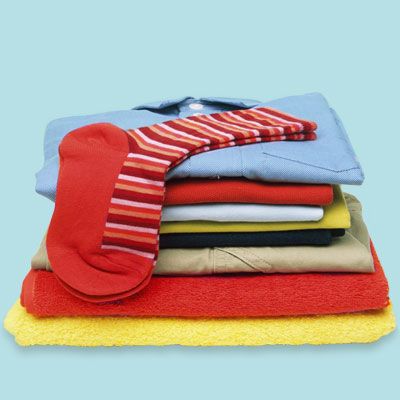
When deciding between gas and electric dryers, the existing connections in your laundry room may dictate your choice. However, if you have both a gas hookup and a 240-volt outlet available, we recommend going with gas.
Gas dryers cost more upfront but can reduce your energy bills in the long run. They generally heat up faster and dry clothes more effectively, which can be beneficial for larger families or those who frequently do laundry. Gas dryers cost about 15–20 cents per load compared to 30–40 cents for electric.
Decoding Energy Star Labels
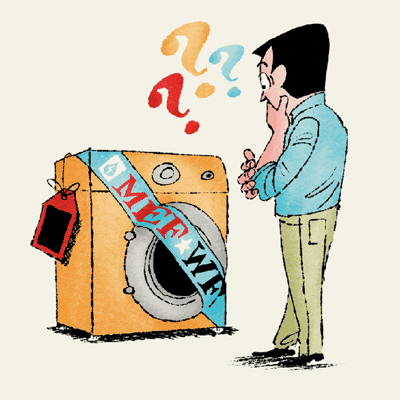
As you shop around for the best laundry machines for your home, you might notice Energy Star labels on some appliances. These labels will help you determine how energy-efficient your new machine is—if you can interpret them correctly. Here are two terms you might come across as you shop:
- Modified Energy Factor (MEF): Measures energy used to run the washer. Higher MEF indicates greater energy efficiency.
- Water Factor (WF): The gallons of water consumed per cubic foot per cycle. Lower WF indicates better water efficiency.
Appliances with high MEF and low WF ratings can generate substantial utility savings over time, making them a smart investment for any household.
Ventilation Checklist
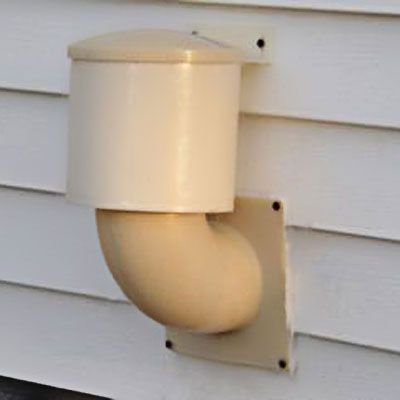
Proper ventilation prevents moisture-related damage and boosts your dryer’s efficiency by reducing energy consumption. Here are some tips to adequately ventilate your laundry room:
- Consider installing a bathroom-type vent fan in the ceiling to prevent moisture buildup, especially in laundry rooms with a stall shower or pet care station.
- Install a self-closing exhaust vent instead of a louvered one to prevent outdoor air from coming inside when the dryer is off.
- Keep metal vent pipe runs to the outdoors as short as possible, with limited bends for optimal airflow (45 feet max, assuming two 90-degree bends).
- Regularly check and clean the vent system to maintain performance and prevent fire hazards.
Picking the Right Ironing Board
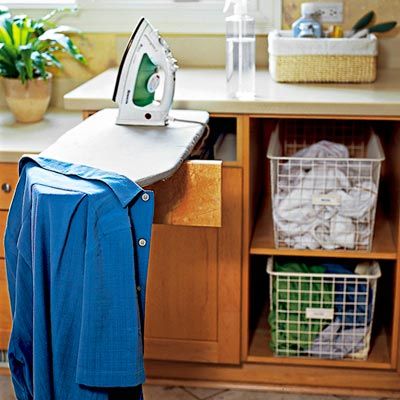
The right ironing board will integrate seamlessly into your laundry room and streamline your ironing process while keeping your space organized. Here are a few options:
- Classic folding board: This is ideal for those who prefer to iron in a different room from where they do their laundry.
- Drop-down board: You can stow a drop-down board in a recessed or wall-mounted cabinet in your laundry room to save space.
- Foldout board: This compact option unfolds from behind a false drawer front for a seamless look, as shown in the image above.
Choosing the Best Laundry Basket
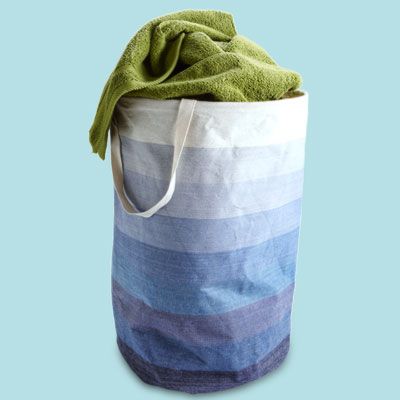
Select the right laundry basket based on your sorting habits and space. If you take sorting seriously, use individual stacking baskets or a metal frame with multiple removable fabric bags. We like rolling garment racks for moving laundry around on the same floor, but if you need to navigate stairs, go for a lightweight, soft-sided vertical bin with loop handles.
Adding a Utility Sink
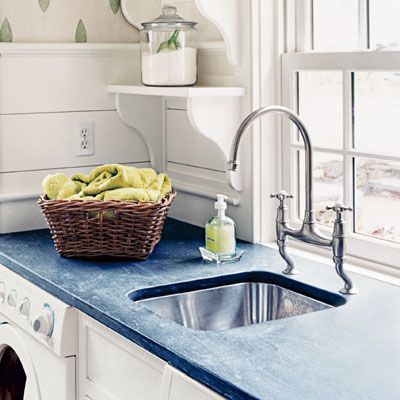
Laundry room sinks are great for hand-washing delicates and filling buckets or watering cans. If you want to install or upgrade a utility sink, consider these tips:
- Choose a 10- to 12-inch-deep square or rectangular stainless steel sink with curved, easy-to-clean corners.
- Consider adding integrated accessories such as built-in washboards or drying racks.
- Install a gooseneck faucet or one with a pullout spray for versatility.
- Install cabinetry around the sink for additional storage space.
Smart and Cheery Finish Materials
Select durable, affordable, and attractive finishes for your laundry room. We recommend looking for water-resistant, easy-to-clean materials that come in styles that match the rest of your home. Consider the following options:
Finishes for Countertops
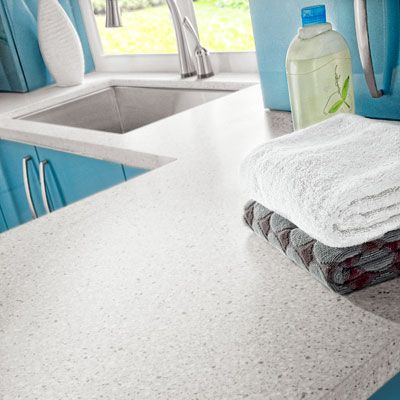
Select practical and attractive countertop materials, such as nonporous solid surfacing (like Corian), engineered stone, or laminate. These options are often more affordable than natural stone and come in various colors and patterns. They’re also resistant to stains and scratches.
Finishes for Floors
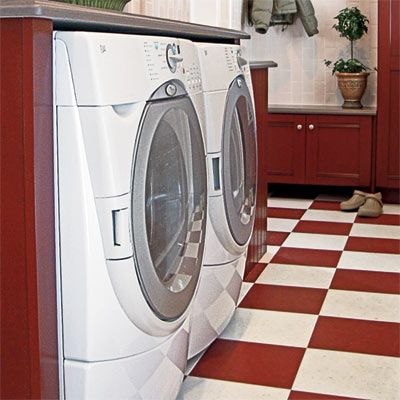
We recommend glue down linoleum, cork, or vinyl floors that resist moisture and require less maintenance than wood or ceramic tiles. These materials are budget-friendly and come in a variety of patterns and colors, allowing you to personalize your space.
Finishes for Storage
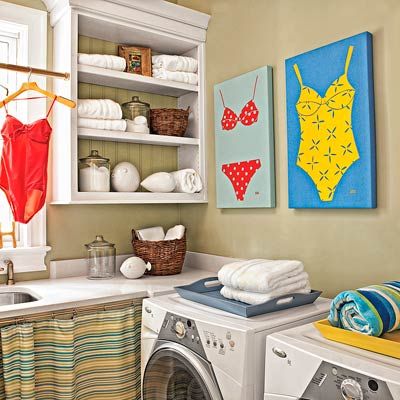
Opt for open shelves and cubbies instead of closed cabinetry for easy access and visual appeal. Use a colorful patterned curtain to conceal clutter under countertops.
Open shelving can make the laundry room feel more spacious and airy while providing practical storage solutions. Using baskets or bins on these shelves can help keep smaller items organized and within reach.
Finishes for Walls
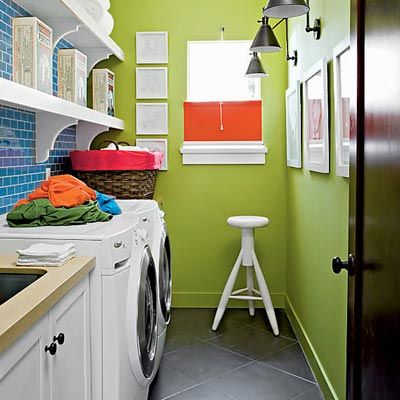
Choose easy-to-clean finishes that add personality to your laundry room. We like practical, stylish wall finishes like semigloss paint, beadboard paneling, and glossy ceramic tiles. Look for colors and patterns that reflect your style.
Laundry Room Lighting
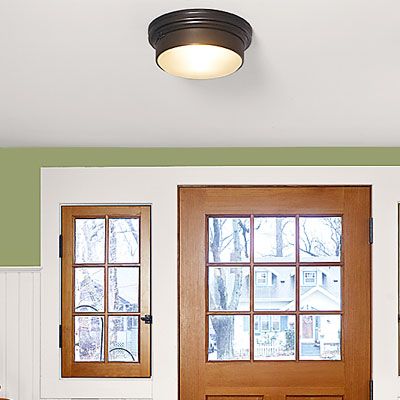
Proper lighting is a key component in any functional laundry room. For general ambient lighting, look for a low-profile ceiling-mounted fixture or stylish pendant. Consider installing LED undercabinet strips or focused overhead spots for task lighting to help with treating stains and ironing.
All the Extras
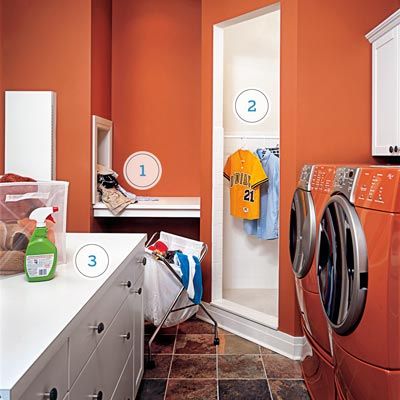
Here are some laundry room splurges that we think are worth the money and effort:
- Add a simple shower stall (see No. 2 in the image above) for pet grooming or rinsing outdoor gear.
- Choose stainless steel washer tubs and dryer drums for longevity and better performance.
- Include a movable or built-in island (see No. 3 in the image above) for extra workspace and storage.
- Install a laundry chute (see No. 1 in the image above) if possible to eliminate trips up and down stairs with dirty clothes.
- Place a television (see No. 4 in the image below) in a convenient spot for entertainment during folding and ironing sessions.
- Replace old washers that are 10+ years old with Energy Star models to save on energy and water bills.
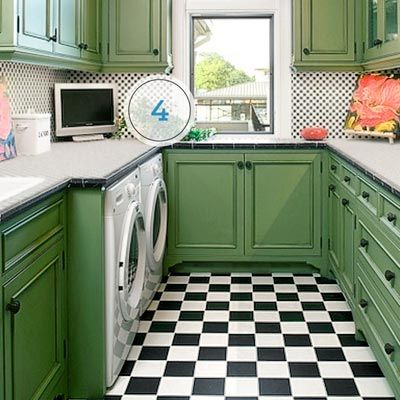
However, some upgrades may not be worth the investment. Some, such as built-in clothing bins, are difficult to clean. Others, such as jetted sinks and steam settings, aren’t really necessary. And still others, such as natural stone counters or drying cabinets, are just too expensive to be worth it.
3 Indoor Air-Dry Options
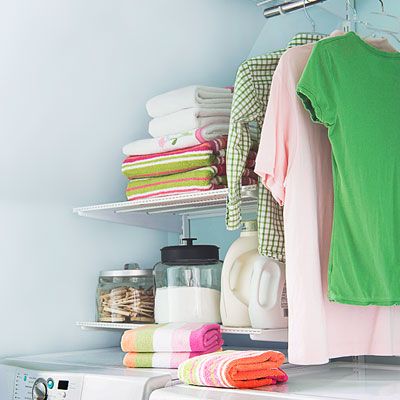
Dryers are second only to refrigerators in terms of appliance energy expenditure. Save energy and extend your clothes’ lifespan with these air-drying solutions:
- Foldaway rack: Choose from wood accordion-style or two-tier metal and mesh folding racks for hanging or laying garments flat.
- Hanging rod: Use a securely mounted metal rod to bear the weight of wet garments.
- Retractable clothesline: Install a wall-mounted pullout clothesline in a well-ventilated area.
Combining multiple solutions can provide flexibility for different types of clothing and laundry loads, helping you air-dry items efficiently and without clutter.
Multitasking Laundries
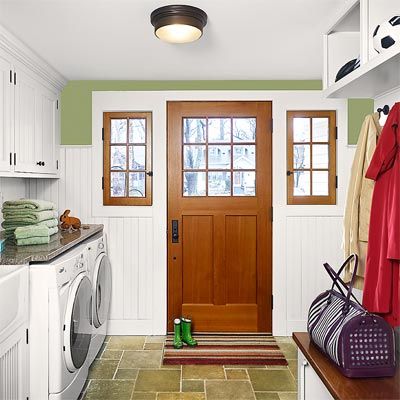
Modern laundry rooms often serve multiple purposes. Consider these dual-function designs:
Mudroom
Combine your laundry area with a mudroom near an entrance to help with dirty clothes and outdoor gear. Include a boot bench with hooks for coats and bags and use closed cabinetry to keep laundry supplies out of sight.
This combination is particularly useful for families with active lifestyles or pets as it provides a designated area for cleaning and storing outdoor items before they enter the home. Add a durable, easy-to-clean flooring material to manage the dirt and moisture brought in from outside.
Bathroom
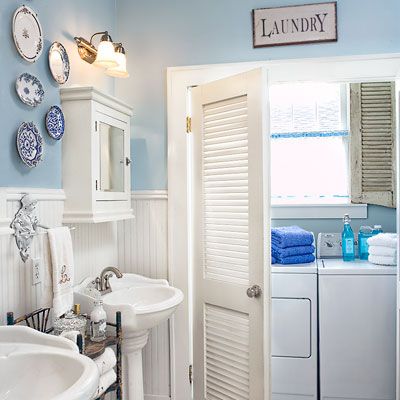
Integrate your laundry area with a bathroom for easy access to warm towels. Use a louvered door to separate the laundry from the bathing area and provide extra ventilation. Proper ventilation is crucial in this arrangement to prevent mold and mildew due to increased humidity levels.
Pet Care Center

Incorporate a pet grooming station in your laundry room with a raised shower pan beside the washer. This setup is perfect for bathing dogs, but you can also use it to spot clean large items such as area rugs.
Dressing Room

Combine your laundry room with a walk-in closet for seamless clothing care. Stacked machines and a built-in dresser that doubles as a folding table maximize efficiency in a compact space. Putting everything in one place streamlines your morning routine and ensures your clothes are always fresh and neatly organized.
Our Conclusion
A modern laundry room is more than just a place to wash and dry clothes. Before you install or redo your laundry facilities, think through your laundry routine to determine how you want to organize your laundry room. You should choose the best appliances, laundry basket, and ironing board that suit your needs while also considering what extras you want to add, such as countertops, sinks, and cabinetry. Your laundry room can even double as a pet care station, mudroom, or dressing room depending on your routine and preferences.
